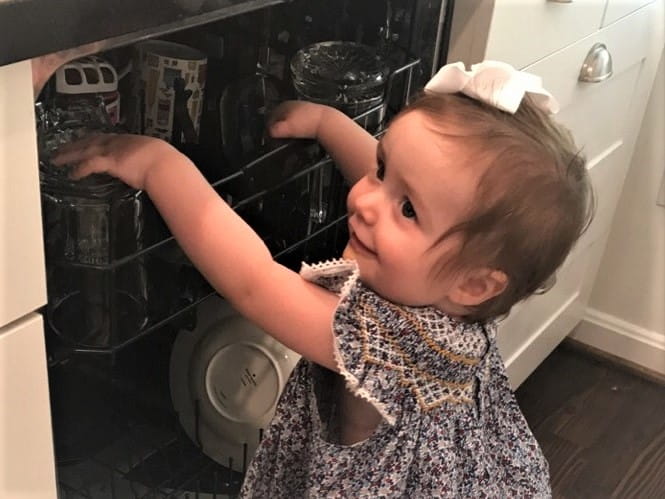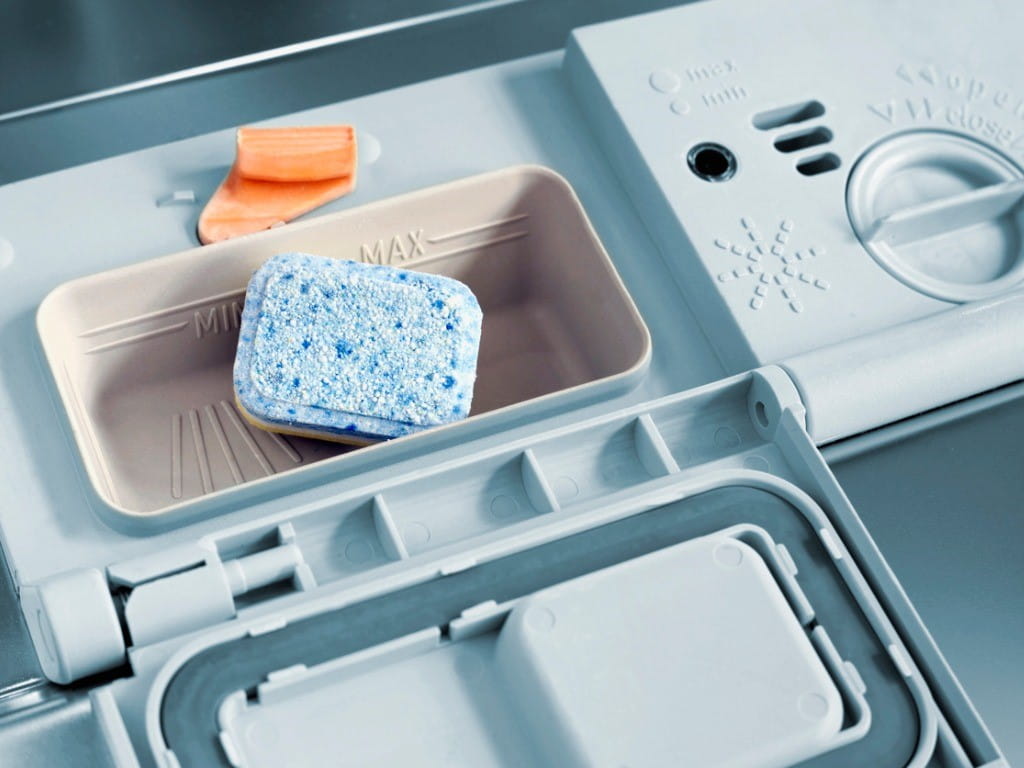My Child Swallowed Dishwashing Detergent

The Bottom Line
Automatic dishwashing detergents (ADDs) are available as powders, liquids, tablets, and pods. Exposure to ADDs is common and often results in irritation. Severe effects, such as burns and tissue damage, can also occur depending on the type of ADD, the amount, and the duration of exposure.

What is an automatic dishwasher detergent?
Automatic dishwashing detergents (ADDs) are available in many forms: powder or granules, liquid or gel, tablets (such as powder blocks), and pods. ADDs have specific ingredients that differentiate them from hand dishwashing detergents. These include strong alkalis, corrosion inhibitors that protect the metallic parts of the dishwasher, and enzymes that break down food. They also contain perfumes that help mask food odors and foam suppressors so that excess foam does not interfere with the cleaning action.
How do automatic dishwasher detergents differ from hand dishwashing detergents?
ADDs and hand dishwashing detergents accomplish the same job but in different environments. ADDs are made to work inside a machine. They rely on the force of sprayed water to scrub dishes. Hand dishwashing detergents are made knowing there will be substantial skin contact as hands do the scrubbing. As a result, hand dishwashing detergents are milder. Using an ADD for hand dishwashing is an invitation to damage skin, while using a hand dishwashing detergent in an automatic dishwasher is an invitation to a foamy mess.
Is automatic dishwasher detergent toxic?
The amount of dishwasher detergent ingested is important in determining whether a person who is exposed to an ADD will have no symptoms, mild symptoms, or severe effects. The majority of exposures are unintentional and by children 5 years of age or younger. It is common for kids to get hold of an ADD from the dishwasher itself. An open dishwasher door, where the dispenser usually sits, is at a child’s eye level. Fortunately, most unintentional ingestions tend to be very small, probably because ADDs have strong, unpleasant tastes. A lick or taste is unlikely to cause anything beyond an icky taste in the mouth. Nausea and vomiting are very common after a sip or a swallow or two.
ADDs are alkaline and have a pH of at least 10. For perspective, a neutral pH—or the pH of water—is around 7. ADDs’ alkalinity gives them a corrosive action against food grime, but also makes them capable of causing tissue injury and burns. Liquid ADDs tend to cause more injury than powders and tablets. This is because their pH tends to be higher—sometimes as high as 13.
What happens if you swallow automatic dishwasher detergent? Is it harmful to your skin or eyes?
ADDs can irritate the mouth, throat, and stomach, resulting in a bad taste, burning throat, nausea, or vomiting. Swallowing an ADD can also result in extreme outcomes, such as severe burns and swelling of the throat, esophagus (food pipe), and stomach. Someone might also choke when swallowing an ADD, causing some to slip into the airway, resulting in coughing, chest pain, wheezing, and shortness of breath.
If an ADD comes into contact with the eye, it can cause discomfort and pain, redness, tearing, and sometimes a scratch or burn on the surface of the eye. If left on the skin for a prolonged time, ADDs can cause skin burns of varying degrees, resulting in redness and pain, peeling, and blistering.
The duration of exposure contributes to the outcome. Don't let an ADD sit on your skin or in your eye. Time allows the product to penetrate the tissue and eat away at it. The longer the exposure, the more severe the injury.
My child swallowed dishwasher detergent. What should I do?
If someone has swallowed an ADD, do not make them vomit. Have them rinse their mouth with water by swishing and spitting a few times. If it just happened, offer sips of water to drink. This will help dilute the product in the stomach, making it less irritating. If an ADD product gets in the eye or on the skin, immediately rinse gently with cool or comfortable-temperature water. Then, get help from Poison Control by checking the webPOISONCONTROL online tool or calling Poison Control at 1-800-222-1222.Serkalem Mekonnen, RN, BSN, MPH
Certified Specialist in Poison Information
Professor of Pharmacy Emeritus
Poison Control Media Information
Did you find this page helpful? If so, we need your support. Poison Control is in constant competition with misinformation online. Links to www.poison.org or our webPOISONCONTROL triage tool from other websites and blogs help internet searchers quickly find accurate information and Poison Control’s contact information in an emergency. If you use the content from this page, please provide attribution via a link back to this page, www.poison.org, or https://triage.webpoisoncontrol.org/#!/exclusions. By doing so, you could save a life. Thank you!
Poisoned?
Call 1-800-222-1222 or
Prevention Tips
- Store automatic dishwashing detergents (ADDs) away from food and out of reach and sight of children, preferably in cabinets with child-resistant closures.
- Keep ADDs in their original containers.
- Wash hands after handling an ADD.
- Use ADDs only as recommended by the manufacturer and for their intended purpose.
This Really Happened
Case 1. A 2-year-old girl put an ADD packet in her mouth and swallowed some of the liquid inside. She vomited immediately. Her mother called Poison Control for advice. She was informed that the product is very irritating but that the child should tolerate the small amount she swallowed. The mother had already given the girl a little milk to drink, and she drank it without any difficulty. Poison Control asked the mother to watch for worsening symptoms or continued vomiting and to call back if symptoms developed. The next day, Poison Control contacted the mother and learned that the girl vomited once more but was fine thereafter.
Case 2. A 48-year-old woman mistakenly washed her hands with automatic dishwashing gel and immediately experienced redness and irritation. By the time she called Poison Control for advice, she had already thoroughly rinsed her hands with water. Poison Control told her to call back if she had any worsening pain or signs of burns, such as blistering. Poison Control contacted her later, and the woman said that the redness and irritation had gone away.
For More Information
Caution With Caustics | Poison Control
Goodbye Winter Grime, Hello Safe Spring Cleaning! | Poison Control
References
Cornish LS, Parsons BJ, Dobbin MD. Automatic dishwasher detergent poisoning: opportunities for prevention. Aust N Z J Public Health. 1996;20(3):278-283.
Davis MG, Casavant MJ, Spiller HA, Chounthirath T, Smith GA. Pediatric exposures to laundry and dishwasher detergents in the United States: 2013-2014. Pediatrics. 2016;137(5):e20154529.
Poisoned?
Call 1-800-222-1222 or
Prevention Tips
- Store automatic dishwashing detergents (ADDs) away from food and out of reach and sight of children, preferably in cabinets with child-resistant closures.
- Keep ADDs in their original containers.
- Wash hands after handling an ADD.
- Use ADDs only as recommended by the manufacturer and for their intended purpose.
This Really Happened
Case 1. A 2-year-old girl put an ADD packet in her mouth and swallowed some of the liquid inside. She vomited immediately. Her mother called Poison Control for advice. She was informed that the product is very irritating but that the child should tolerate the small amount she swallowed. The mother had already given the girl a little milk to drink, and she drank it without any difficulty. Poison Control asked the mother to watch for worsening symptoms or continued vomiting and to call back if symptoms developed. The next day, Poison Control contacted the mother and learned that the girl vomited once more but was fine thereafter.
Case 2. A 48-year-old woman mistakenly washed her hands with automatic dishwashing gel and immediately experienced redness and irritation. By the time she called Poison Control for advice, she had already thoroughly rinsed her hands with water. Poison Control told her to call back if she had any worsening pain or signs of burns, such as blistering. Poison Control contacted her later, and the woman said that the redness and irritation had gone away.
